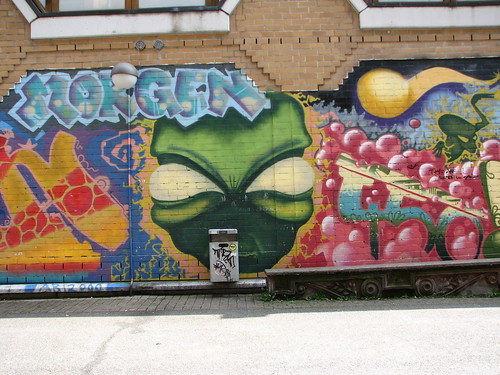I just ran across an interesting article about the German town of Rummelsheim. Know for its cleanliness and organization, the community has recently been faced with an interesting problem. Despite strict laws governing the removal of trash, a toy shrine has existed in defiance to the laws. This toy shrine, described as "kitsch" has won a place in the hearts of many local residents.
So as I reflect on the cultural presentations we hold in our aesthetics class, I can't help but wonder what role order and civic responsibility play in the German aesthetic. When I visited Germany last year, I do remember seeing graffiti. Where does that fit in the aesthetic? Unlike the toy shrine, the graffiti in Germany isn't actually waste. In fact, it was generally more impressive to me in regard to artistry. Here's an example:
I remember my father telling me that you could always tell when you were in a German community while driving in rural Texas. German farmers had the best fences and they would blast and haul stones out of the fields. They always had well maintained irrigation terraces. While riding on the bus in Germany, I watched in amazement as I saw field after field of agricultural precision. It reminded me of David Hockney's landscapes.
I sometimes wish that people in the US had such a drive to interact with their environment with more care and precision. I grew up seeing this as one of frames of reference for public art. 
While I love Ant Farm and the Cadillac Ranch, the comparison made me stop to consider my notes regarding the role of cultural aesthetic in such matters.
So what does the difference between US and German public landscape aesthetics indicate about the people? Why is there such a noticeable difference between the two cultures?
Tuesday, February 26, 2008
Public Art or Crime?
Posted by
Lillian Lewis
at
2/26/2008 11:29:00 AM
![]() Labels:
aesthetics,
art,
Germany,
reflection
Labels:
aesthetics,
art,
Germany,
reflection
Subscribe to:
Post Comments (Atom)


1 comment:
Well, then I was alerted to this article, just to further the Germany graffiti discussion:
http://travel.nytimes.com/2008/03/02/travel/02headsup.html
Apparently the graffiti issue is complex in Germany. It seems to be a combination factors.
Post a Comment